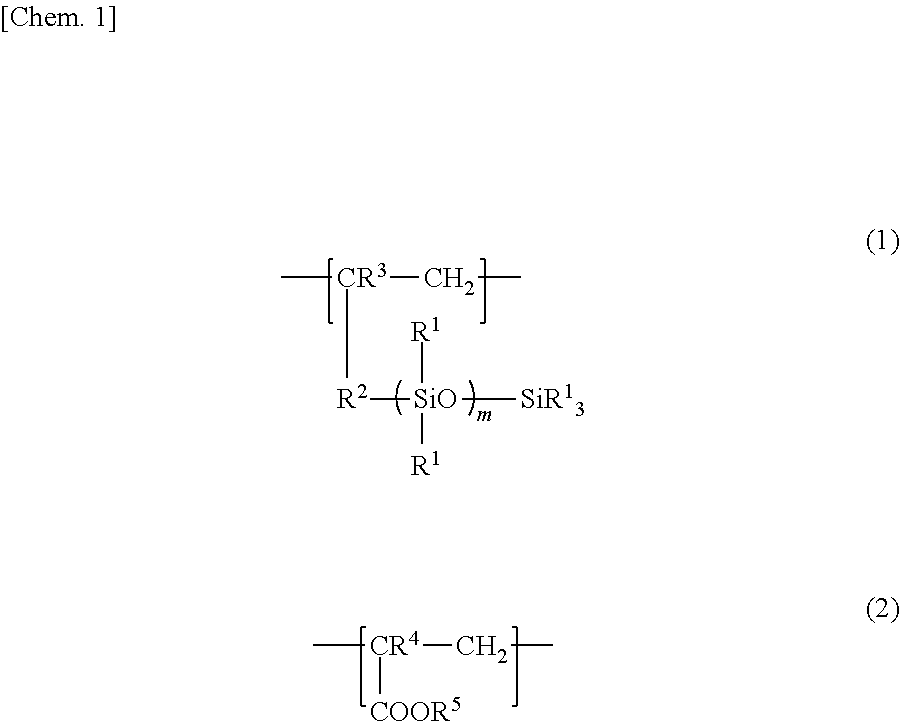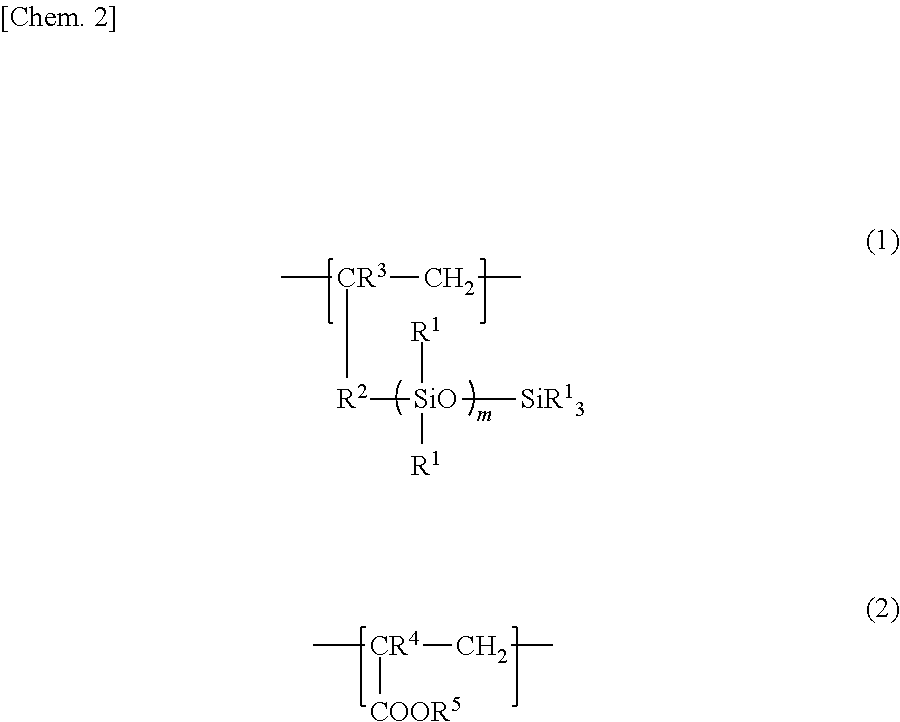Method for preparing oil-in-water type emulsion composition, and cosmetic material
a technology of oil-in-water emulsion composition and composition, which is applied in the field of oil-in-water emulsion composition and cosmetic materials, can solve the problems of poor shelf stability, reduced water resistance, concentration separation, etc., and achieves mild skin, good coating properties, and film formability.
- Summary
- Abstract
- Description
- Claims
- Application Information
AI Technical Summary
Benefits of technology
Problems solved by technology
Method used
Image
Examples
synthesis example 1
[0082]A toluene solution of component (A-1) an acrylic-silicone copolymer of structural formula (11) below was obtained by mixing together 100 g of a monomethacrylate-terminated dimethylpolysiloxane of formula (10) below, 80 g of methyl methacrylate, 20 g of 2-ethylhexyl acrylate and 200 g of toluene, subsequently adding and dissolving 2 g of t-butylperoxy-2-ethylhexyl hexanoate (NOF Corporation, Perbutyl O), and then reacting for 10 hours under a nitrogen atmosphere and in a temperature range of between 90 and 100° C. The polystyrene-equivalent weight-average molecular weight determined by GPC (toluene) was about 25,000.
[0083]
Constituent unit molar ratio (1) / (2)=1 / (2.5+18.3)=0.05
[0084]Four hundred grams of the toluene solution of the copolymer of formula (11) was heated under reduced pressure at 130° C. and 10 mmHg, driving off the toluene and acrylic monomer, following which 200 g of isododecane was added and heating was carried out under reduced pressure at 130° C. and 10 mmHg, d...
synthesis example 2
[0085]Four hundred grams of the toluene solution of acrylic-silicone copolymer (A) obtained in Synthesis Example 1 was heated under reduced pressure at 130° C. and 10 mmHg, driving off the toluene and the acrylic monomer, following which 200 g of isododecane was added and heating under reduced pressure was carried out at 130° C. and 10 mmHg, driving off the isododecane and the acrylic monomer. Next, 300 g of (B-1) isododecane was added and the (A) acrylic-silicone copolymer was dissolved, giving Mixed Solution (ii). The ratio expressed as (A-1) / (B-1) was about 40 / 60, and the viscosity (25° C.) of Mixed Solution (ii) was 320 mm2 / s. The methyl methacrylate and 2-ethylhexyl acrylate were each less than 10 ppm.
synthesis example 3
[0086]Four hundred grams of the toluene solution of acrylic-silicone copolymer (A) obtained in Synthesis Example 1 was heated under reduced pressure at 130° C. and 10 mmHg, driving off the toluene and the acrylic monomer, following which 200 g of isododecane was added and heating under reduced pressure was carried out at 130° C. and 10 mmHg, driving off the isododecane and the acrylic monomer. Next, 470 g of the silicone compound of formula (12) below as component (B-2) was added and the (A) acrylic-silicone copolymer was dissolved, giving Mixed Solution (iii). The ratio expressed as (A-1) / (B-2) was about 30 / 70, and the viscosity (25° C.) of Mixed Solution (iii) was 40 mm2 / s. The methyl methacrylate and 2-ethylhexyl acrylate contents were each less than 10 ppm.
[0087]
PUM
| Property | Measurement | Unit |
|---|---|---|
| molar ratio | aaaaa | aaaaa |
| molar ratio | aaaaa | aaaaa |
| shear pressure | aaaaa | aaaaa |
Abstract
Description
Claims
Application Information
 Login to View More
Login to View More - R&D
- Intellectual Property
- Life Sciences
- Materials
- Tech Scout
- Unparalleled Data Quality
- Higher Quality Content
- 60% Fewer Hallucinations
Browse by: Latest US Patents, China's latest patents, Technical Efficacy Thesaurus, Application Domain, Technology Topic, Popular Technical Reports.
© 2025 PatSnap. All rights reserved.Legal|Privacy policy|Modern Slavery Act Transparency Statement|Sitemap|About US| Contact US: help@patsnap.com



